A Look into Schizophrenia
VerifiedAdded on 2023/04/22
|9
|2151
|227
AI Summary
This assignment evaluates the psychological theories related to Schizophrenia and discusses evidence-based interventions that can help in controlling the symptoms of the disorder. It also provides an overview of the pathophysiology, prevalence, and treatment options for Schizophrenia.
Contribute Materials
Your contribution can guide someone’s learning journey. Share your
documents today.
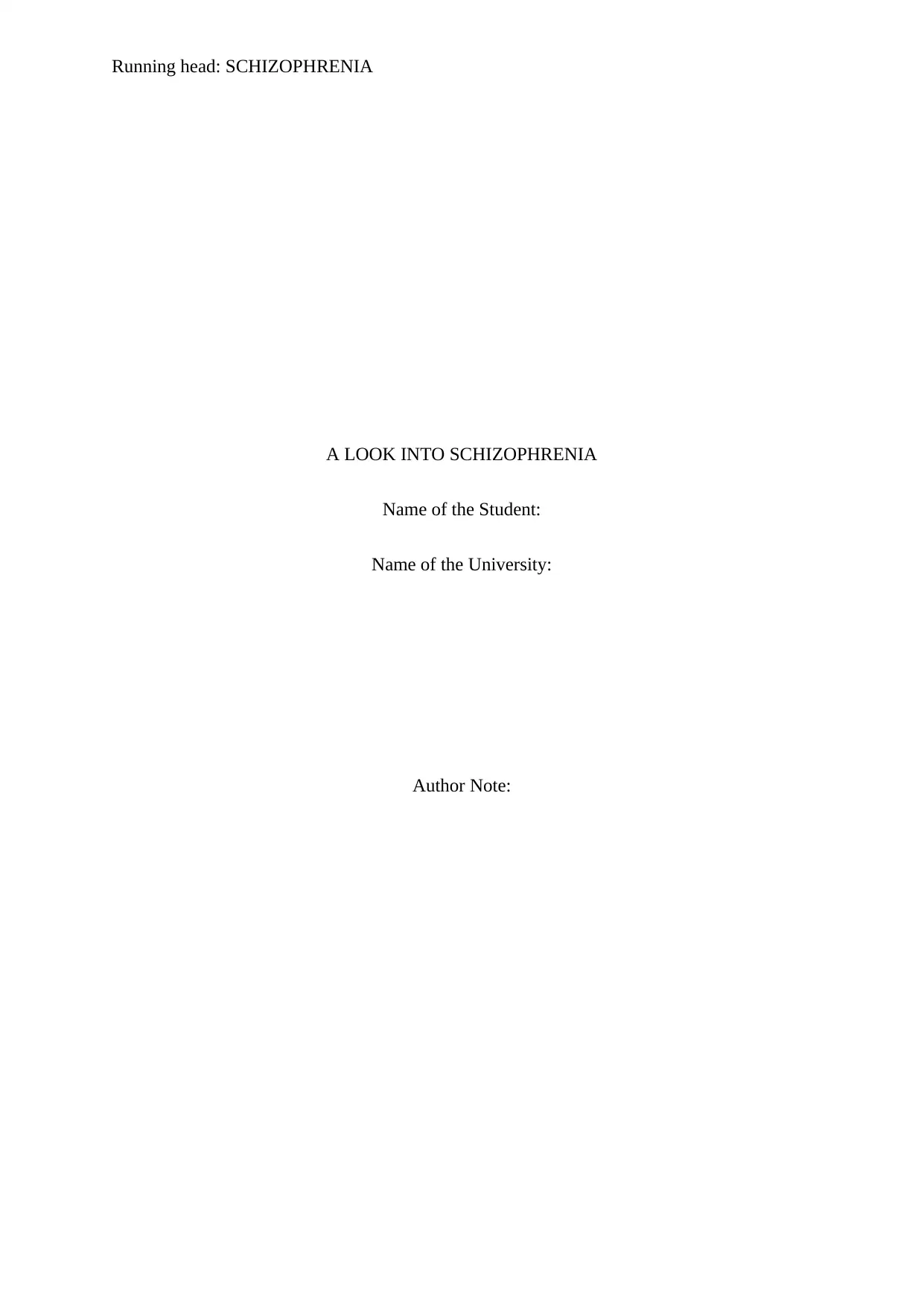
Running head: SCHIZOPHRENIA
A LOOK INTO SCHIZOPHRENIA
Name of the Student:
Name of the University:
Author Note:
A LOOK INTO SCHIZOPHRENIA
Name of the Student:
Name of the University:
Author Note:
Secure Best Marks with AI Grader
Need help grading? Try our AI Grader for instant feedback on your assignments.

1SCHIZOPHRENIA
Introduction:
Schizophrenia can be defined as a chronic mental health condition that affects the
ability of a person to think, feel and respond to situations. Patients suffering from
Schizophrenia seem to have lost contact with reality. It should be mentioned in this regard
that Schizophrenia is not one among the most common mental health disorders, however the
symptoms of the disorder are extremely challenging to control. According to the statistical
evidences published by the National Institute of Mental Health (2019), it has been mentioned
that the prevalence of Schizophrenia in U.S adults vary in between 0.25% to 0.64%. In
addition to this, the global prevalence of Schizophrenia has been reported to be in between
0.33% to 0.75% (Nimh.nih.gov, 2019). It should be mentioned in this context that it is
extremely difficult for researchers to estimate the accurate epidemiological data related to
Schizophrenia on account of its complicated pathophysiology that overlaps with other mental
health disorders such as autism where the case assumes a serious dimension (Vaskinn, Anja
& Ahmad, 2019). This subsequently accounts for the reason why epidemiological studies
often estimate the prevalence percentage of Schizophrenia in combination with other mental
health disorders. Despite the meagre prevalence percentage of Schizophrenia, it has been
reported as one of the leading causes of disability globally. Patients suffering from
Schizophrenia are placed at an increased risk of premature death. Studies reveal that the
average age at the time of death due to Schizophrenia is equivalent to 28.5 years
(Nimh.nih.gov, 2019). In addition to this, the medical condition is often assisted with
cardiovascular disorders, liver disease and diabetes. Also, 4.9% of people suffering from the
disorder attempt suicide annually which makes the disease condition a global concern
(Nimh.nih.gov, 2019). This assignment aims to evaluate the psychological theories that are
Introduction:
Schizophrenia can be defined as a chronic mental health condition that affects the
ability of a person to think, feel and respond to situations. Patients suffering from
Schizophrenia seem to have lost contact with reality. It should be mentioned in this regard
that Schizophrenia is not one among the most common mental health disorders, however the
symptoms of the disorder are extremely challenging to control. According to the statistical
evidences published by the National Institute of Mental Health (2019), it has been mentioned
that the prevalence of Schizophrenia in U.S adults vary in between 0.25% to 0.64%. In
addition to this, the global prevalence of Schizophrenia has been reported to be in between
0.33% to 0.75% (Nimh.nih.gov, 2019). It should be mentioned in this context that it is
extremely difficult for researchers to estimate the accurate epidemiological data related to
Schizophrenia on account of its complicated pathophysiology that overlaps with other mental
health disorders such as autism where the case assumes a serious dimension (Vaskinn, Anja
& Ahmad, 2019). This subsequently accounts for the reason why epidemiological studies
often estimate the prevalence percentage of Schizophrenia in combination with other mental
health disorders. Despite the meagre prevalence percentage of Schizophrenia, it has been
reported as one of the leading causes of disability globally. Patients suffering from
Schizophrenia are placed at an increased risk of premature death. Studies reveal that the
average age at the time of death due to Schizophrenia is equivalent to 28.5 years
(Nimh.nih.gov, 2019). In addition to this, the medical condition is often assisted with
cardiovascular disorders, liver disease and diabetes. Also, 4.9% of people suffering from the
disorder attempt suicide annually which makes the disease condition a global concern
(Nimh.nih.gov, 2019). This assignment aims to evaluate the psychological theories that are
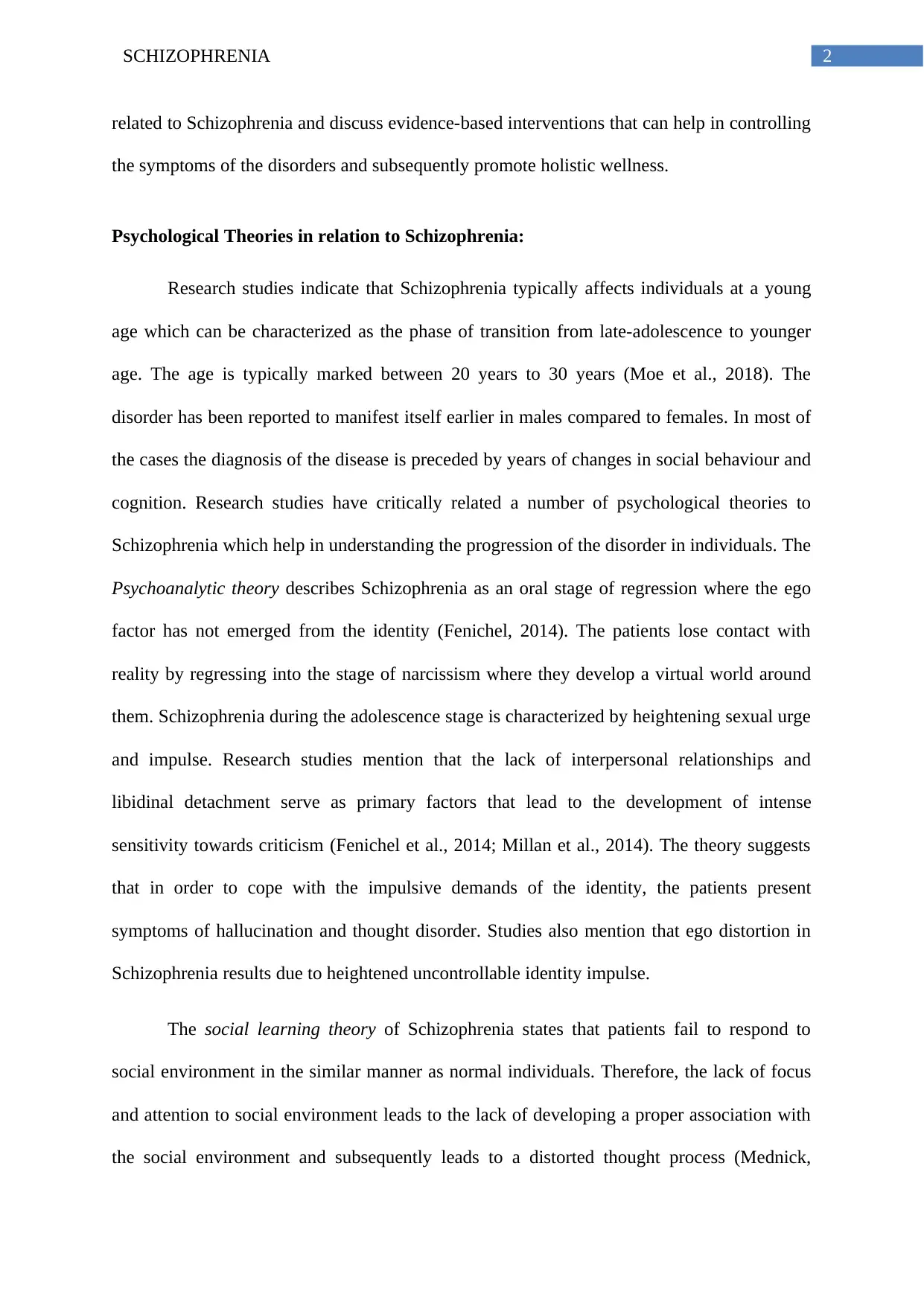
2SCHIZOPHRENIA
related to Schizophrenia and discuss evidence-based interventions that can help in controlling
the symptoms of the disorders and subsequently promote holistic wellness.
Psychological Theories in relation to Schizophrenia:
Research studies indicate that Schizophrenia typically affects individuals at a young
age which can be characterized as the phase of transition from late-adolescence to younger
age. The age is typically marked between 20 years to 30 years (Moe et al., 2018). The
disorder has been reported to manifest itself earlier in males compared to females. In most of
the cases the diagnosis of the disease is preceded by years of changes in social behaviour and
cognition. Research studies have critically related a number of psychological theories to
Schizophrenia which help in understanding the progression of the disorder in individuals. The
Psychoanalytic theory describes Schizophrenia as an oral stage of regression where the ego
factor has not emerged from the identity (Fenichel, 2014). The patients lose contact with
reality by regressing into the stage of narcissism where they develop a virtual world around
them. Schizophrenia during the adolescence stage is characterized by heightening sexual urge
and impulse. Research studies mention that the lack of interpersonal relationships and
libidinal detachment serve as primary factors that lead to the development of intense
sensitivity towards criticism (Fenichel et al., 2014; Millan et al., 2014). The theory suggests
that in order to cope with the impulsive demands of the identity, the patients present
symptoms of hallucination and thought disorder. Studies also mention that ego distortion in
Schizophrenia results due to heightened uncontrollable identity impulse.
The social learning theory of Schizophrenia states that patients fail to respond to
social environment in the similar manner as normal individuals. Therefore, the lack of focus
and attention to social environment leads to the lack of developing a proper association with
the social environment and subsequently leads to a distorted thought process (Mednick,
related to Schizophrenia and discuss evidence-based interventions that can help in controlling
the symptoms of the disorders and subsequently promote holistic wellness.
Psychological Theories in relation to Schizophrenia:
Research studies indicate that Schizophrenia typically affects individuals at a young
age which can be characterized as the phase of transition from late-adolescence to younger
age. The age is typically marked between 20 years to 30 years (Moe et al., 2018). The
disorder has been reported to manifest itself earlier in males compared to females. In most of
the cases the diagnosis of the disease is preceded by years of changes in social behaviour and
cognition. Research studies have critically related a number of psychological theories to
Schizophrenia which help in understanding the progression of the disorder in individuals. The
Psychoanalytic theory describes Schizophrenia as an oral stage of regression where the ego
factor has not emerged from the identity (Fenichel, 2014). The patients lose contact with
reality by regressing into the stage of narcissism where they develop a virtual world around
them. Schizophrenia during the adolescence stage is characterized by heightening sexual urge
and impulse. Research studies mention that the lack of interpersonal relationships and
libidinal detachment serve as primary factors that lead to the development of intense
sensitivity towards criticism (Fenichel et al., 2014; Millan et al., 2014). The theory suggests
that in order to cope with the impulsive demands of the identity, the patients present
symptoms of hallucination and thought disorder. Studies also mention that ego distortion in
Schizophrenia results due to heightened uncontrollable identity impulse.
The social learning theory of Schizophrenia states that patients fail to respond to
social environment in the similar manner as normal individuals. Therefore, the lack of focus
and attention to social environment leads to the lack of developing a proper association with
the social environment and subsequently leads to a distorted thought process (Mednick,
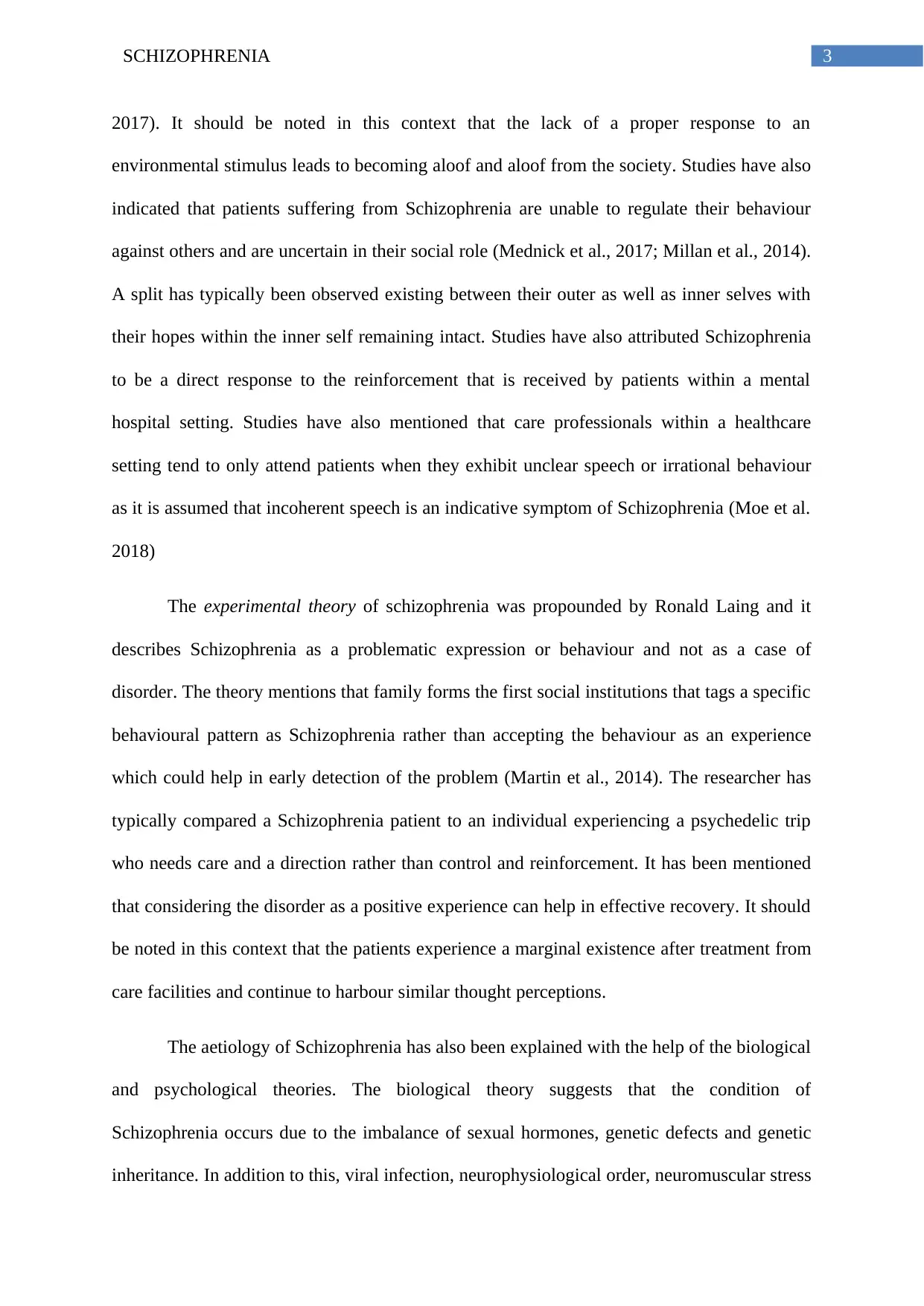
3SCHIZOPHRENIA
2017). It should be noted in this context that the lack of a proper response to an
environmental stimulus leads to becoming aloof and aloof from the society. Studies have also
indicated that patients suffering from Schizophrenia are unable to regulate their behaviour
against others and are uncertain in their social role (Mednick et al., 2017; Millan et al., 2014).
A split has typically been observed existing between their outer as well as inner selves with
their hopes within the inner self remaining intact. Studies have also attributed Schizophrenia
to be a direct response to the reinforcement that is received by patients within a mental
hospital setting. Studies have also mentioned that care professionals within a healthcare
setting tend to only attend patients when they exhibit unclear speech or irrational behaviour
as it is assumed that incoherent speech is an indicative symptom of Schizophrenia (Moe et al.
2018)
The experimental theory of schizophrenia was propounded by Ronald Laing and it
describes Schizophrenia as a problematic expression or behaviour and not as a case of
disorder. The theory mentions that family forms the first social institutions that tags a specific
behavioural pattern as Schizophrenia rather than accepting the behaviour as an experience
which could help in early detection of the problem (Martin et al., 2014). The researcher has
typically compared a Schizophrenia patient to an individual experiencing a psychedelic trip
who needs care and a direction rather than control and reinforcement. It has been mentioned
that considering the disorder as a positive experience can help in effective recovery. It should
be noted in this context that the patients experience a marginal existence after treatment from
care facilities and continue to harbour similar thought perceptions.
The aetiology of Schizophrenia has also been explained with the help of the biological
and psychological theories. The biological theory suggests that the condition of
Schizophrenia occurs due to the imbalance of sexual hormones, genetic defects and genetic
inheritance. In addition to this, viral infection, neurophysiological order, neuromuscular stress
2017). It should be noted in this context that the lack of a proper response to an
environmental stimulus leads to becoming aloof and aloof from the society. Studies have also
indicated that patients suffering from Schizophrenia are unable to regulate their behaviour
against others and are uncertain in their social role (Mednick et al., 2017; Millan et al., 2014).
A split has typically been observed existing between their outer as well as inner selves with
their hopes within the inner self remaining intact. Studies have also attributed Schizophrenia
to be a direct response to the reinforcement that is received by patients within a mental
hospital setting. Studies have also mentioned that care professionals within a healthcare
setting tend to only attend patients when they exhibit unclear speech or irrational behaviour
as it is assumed that incoherent speech is an indicative symptom of Schizophrenia (Moe et al.
2018)
The experimental theory of schizophrenia was propounded by Ronald Laing and it
describes Schizophrenia as a problematic expression or behaviour and not as a case of
disorder. The theory mentions that family forms the first social institutions that tags a specific
behavioural pattern as Schizophrenia rather than accepting the behaviour as an experience
which could help in early detection of the problem (Martin et al., 2014). The researcher has
typically compared a Schizophrenia patient to an individual experiencing a psychedelic trip
who needs care and a direction rather than control and reinforcement. It has been mentioned
that considering the disorder as a positive experience can help in effective recovery. It should
be noted in this context that the patients experience a marginal existence after treatment from
care facilities and continue to harbour similar thought perceptions.
The aetiology of Schizophrenia has also been explained with the help of the biological
and psychological theories. The biological theory suggests that the condition of
Schizophrenia occurs due to the imbalance of sexual hormones, genetic defects and genetic
inheritance. In addition to this, viral infection, neurophysiological order, neuromuscular stress
Secure Best Marks with AI Grader
Need help grading? Try our AI Grader for instant feedback on your assignments.
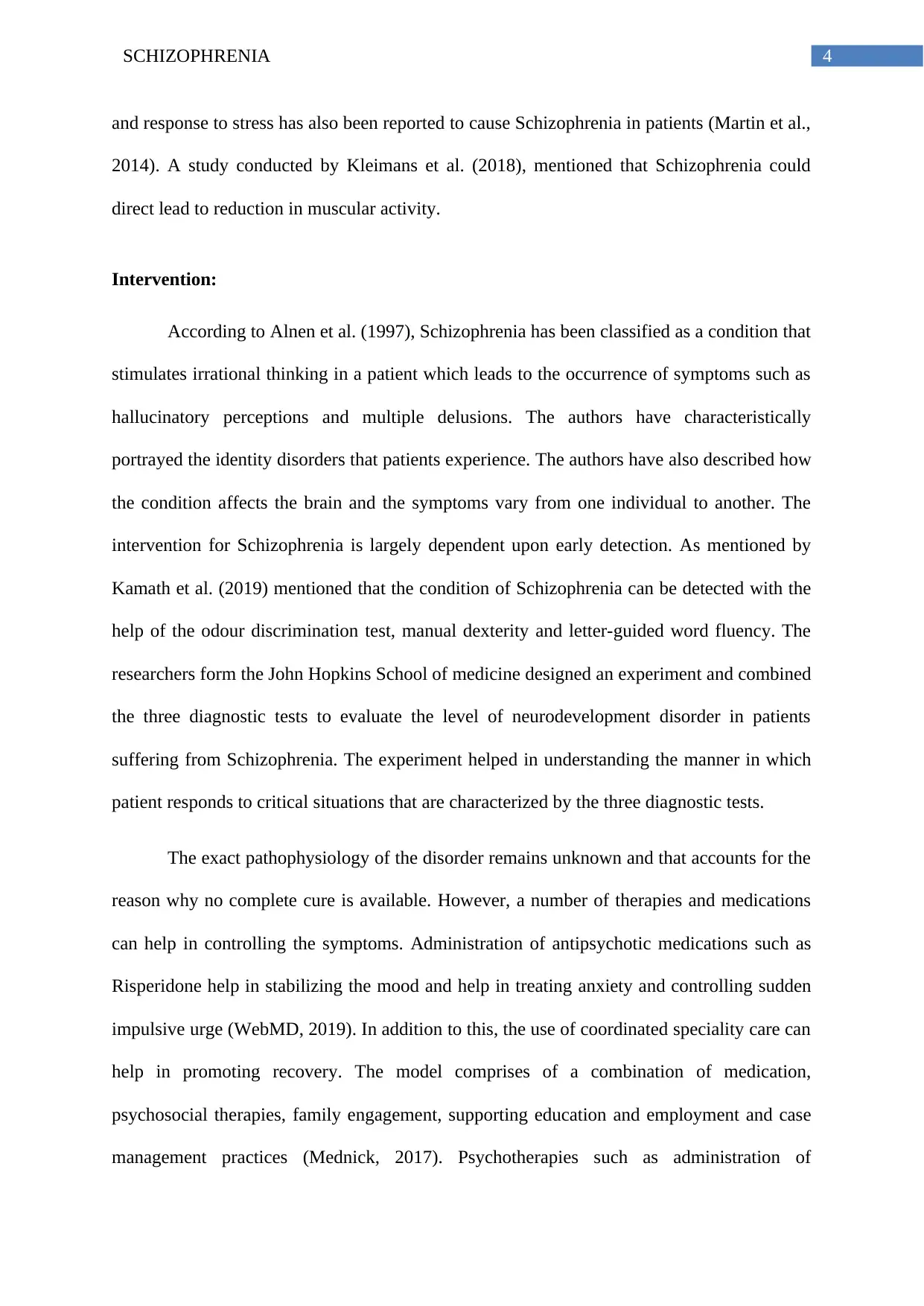
4SCHIZOPHRENIA
and response to stress has also been reported to cause Schizophrenia in patients (Martin et al.,
2014). A study conducted by Kleimans et al. (2018), mentioned that Schizophrenia could
direct lead to reduction in muscular activity.
Intervention:
According to Alnen et al. (1997), Schizophrenia has been classified as a condition that
stimulates irrational thinking in a patient which leads to the occurrence of symptoms such as
hallucinatory perceptions and multiple delusions. The authors have characteristically
portrayed the identity disorders that patients experience. The authors have also described how
the condition affects the brain and the symptoms vary from one individual to another. The
intervention for Schizophrenia is largely dependent upon early detection. As mentioned by
Kamath et al. (2019) mentioned that the condition of Schizophrenia can be detected with the
help of the odour discrimination test, manual dexterity and letter-guided word fluency. The
researchers form the John Hopkins School of medicine designed an experiment and combined
the three diagnostic tests to evaluate the level of neurodevelopment disorder in patients
suffering from Schizophrenia. The experiment helped in understanding the manner in which
patient responds to critical situations that are characterized by the three diagnostic tests.
The exact pathophysiology of the disorder remains unknown and that accounts for the
reason why no complete cure is available. However, a number of therapies and medications
can help in controlling the symptoms. Administration of antipsychotic medications such as
Risperidone help in stabilizing the mood and help in treating anxiety and controlling sudden
impulsive urge (WebMD, 2019). In addition to this, the use of coordinated speciality care can
help in promoting recovery. The model comprises of a combination of medication,
psychosocial therapies, family engagement, supporting education and employment and case
management practices (Mednick, 2017). Psychotherapies such as administration of
and response to stress has also been reported to cause Schizophrenia in patients (Martin et al.,
2014). A study conducted by Kleimans et al. (2018), mentioned that Schizophrenia could
direct lead to reduction in muscular activity.
Intervention:
According to Alnen et al. (1997), Schizophrenia has been classified as a condition that
stimulates irrational thinking in a patient which leads to the occurrence of symptoms such as
hallucinatory perceptions and multiple delusions. The authors have characteristically
portrayed the identity disorders that patients experience. The authors have also described how
the condition affects the brain and the symptoms vary from one individual to another. The
intervention for Schizophrenia is largely dependent upon early detection. As mentioned by
Kamath et al. (2019) mentioned that the condition of Schizophrenia can be detected with the
help of the odour discrimination test, manual dexterity and letter-guided word fluency. The
researchers form the John Hopkins School of medicine designed an experiment and combined
the three diagnostic tests to evaluate the level of neurodevelopment disorder in patients
suffering from Schizophrenia. The experiment helped in understanding the manner in which
patient responds to critical situations that are characterized by the three diagnostic tests.
The exact pathophysiology of the disorder remains unknown and that accounts for the
reason why no complete cure is available. However, a number of therapies and medications
can help in controlling the symptoms. Administration of antipsychotic medications such as
Risperidone help in stabilizing the mood and help in treating anxiety and controlling sudden
impulsive urge (WebMD, 2019). In addition to this, the use of coordinated speciality care can
help in promoting recovery. The model comprises of a combination of medication,
psychosocial therapies, family engagement, supporting education and employment and case
management practices (Mednick, 2017). Psychotherapies such as administration of
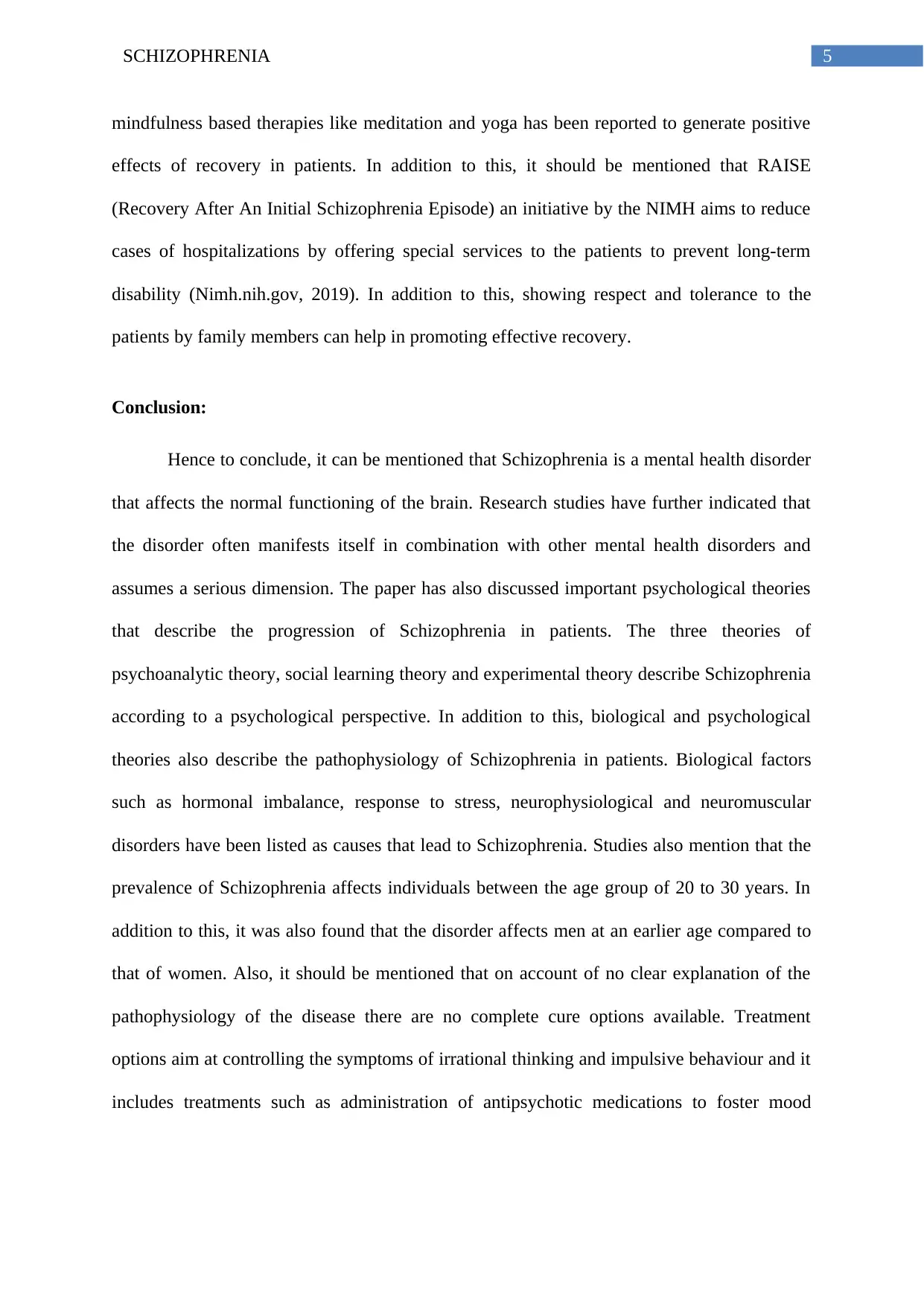
5SCHIZOPHRENIA
mindfulness based therapies like meditation and yoga has been reported to generate positive
effects of recovery in patients. In addition to this, it should be mentioned that RAISE
(Recovery After An Initial Schizophrenia Episode) an initiative by the NIMH aims to reduce
cases of hospitalizations by offering special services to the patients to prevent long-term
disability (Nimh.nih.gov, 2019). In addition to this, showing respect and tolerance to the
patients by family members can help in promoting effective recovery.
Conclusion:
Hence to conclude, it can be mentioned that Schizophrenia is a mental health disorder
that affects the normal functioning of the brain. Research studies have further indicated that
the disorder often manifests itself in combination with other mental health disorders and
assumes a serious dimension. The paper has also discussed important psychological theories
that describe the progression of Schizophrenia in patients. The three theories of
psychoanalytic theory, social learning theory and experimental theory describe Schizophrenia
according to a psychological perspective. In addition to this, biological and psychological
theories also describe the pathophysiology of Schizophrenia in patients. Biological factors
such as hormonal imbalance, response to stress, neurophysiological and neuromuscular
disorders have been listed as causes that lead to Schizophrenia. Studies also mention that the
prevalence of Schizophrenia affects individuals between the age group of 20 to 30 years. In
addition to this, it was also found that the disorder affects men at an earlier age compared to
that of women. Also, it should be mentioned that on account of no clear explanation of the
pathophysiology of the disease there are no complete cure options available. Treatment
options aim at controlling the symptoms of irrational thinking and impulsive behaviour and it
includes treatments such as administration of antipsychotic medications to foster mood
mindfulness based therapies like meditation and yoga has been reported to generate positive
effects of recovery in patients. In addition to this, it should be mentioned that RAISE
(Recovery After An Initial Schizophrenia Episode) an initiative by the NIMH aims to reduce
cases of hospitalizations by offering special services to the patients to prevent long-term
disability (Nimh.nih.gov, 2019). In addition to this, showing respect and tolerance to the
patients by family members can help in promoting effective recovery.
Conclusion:
Hence to conclude, it can be mentioned that Schizophrenia is a mental health disorder
that affects the normal functioning of the brain. Research studies have further indicated that
the disorder often manifests itself in combination with other mental health disorders and
assumes a serious dimension. The paper has also discussed important psychological theories
that describe the progression of Schizophrenia in patients. The three theories of
psychoanalytic theory, social learning theory and experimental theory describe Schizophrenia
according to a psychological perspective. In addition to this, biological and psychological
theories also describe the pathophysiology of Schizophrenia in patients. Biological factors
such as hormonal imbalance, response to stress, neurophysiological and neuromuscular
disorders have been listed as causes that lead to Schizophrenia. Studies also mention that the
prevalence of Schizophrenia affects individuals between the age group of 20 to 30 years. In
addition to this, it was also found that the disorder affects men at an earlier age compared to
that of women. Also, it should be mentioned that on account of no clear explanation of the
pathophysiology of the disease there are no complete cure options available. Treatment
options aim at controlling the symptoms of irrational thinking and impulsive behaviour and it
includes treatments such as administration of antipsychotic medications to foster mood
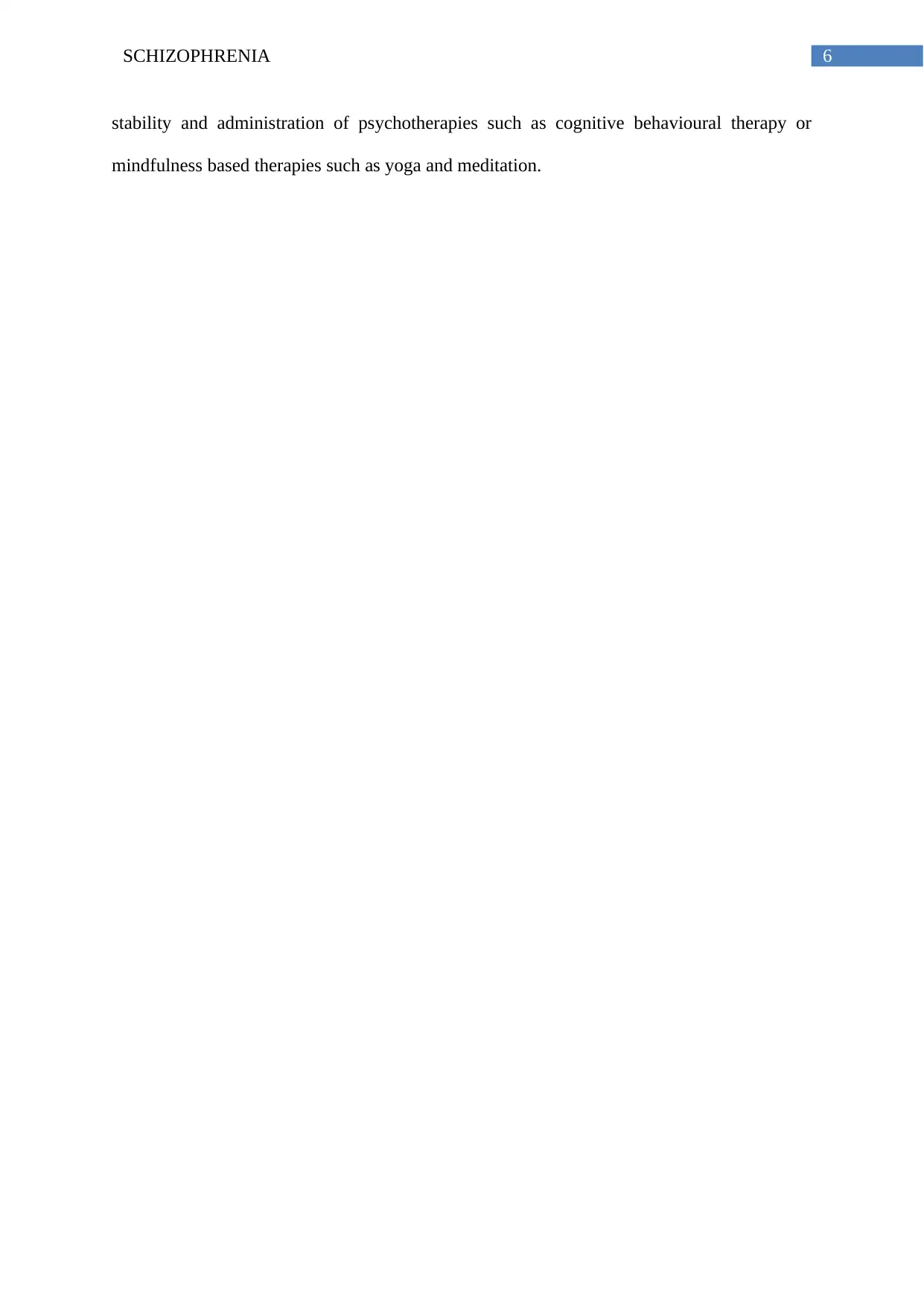
6SCHIZOPHRENIA
stability and administration of psychotherapies such as cognitive behavioural therapy or
mindfulness based therapies such as yoga and meditation.
stability and administration of psychotherapies such as cognitive behavioural therapy or
mindfulness based therapies such as yoga and meditation.
Paraphrase This Document
Need a fresh take? Get an instant paraphrase of this document with our AI Paraphraser
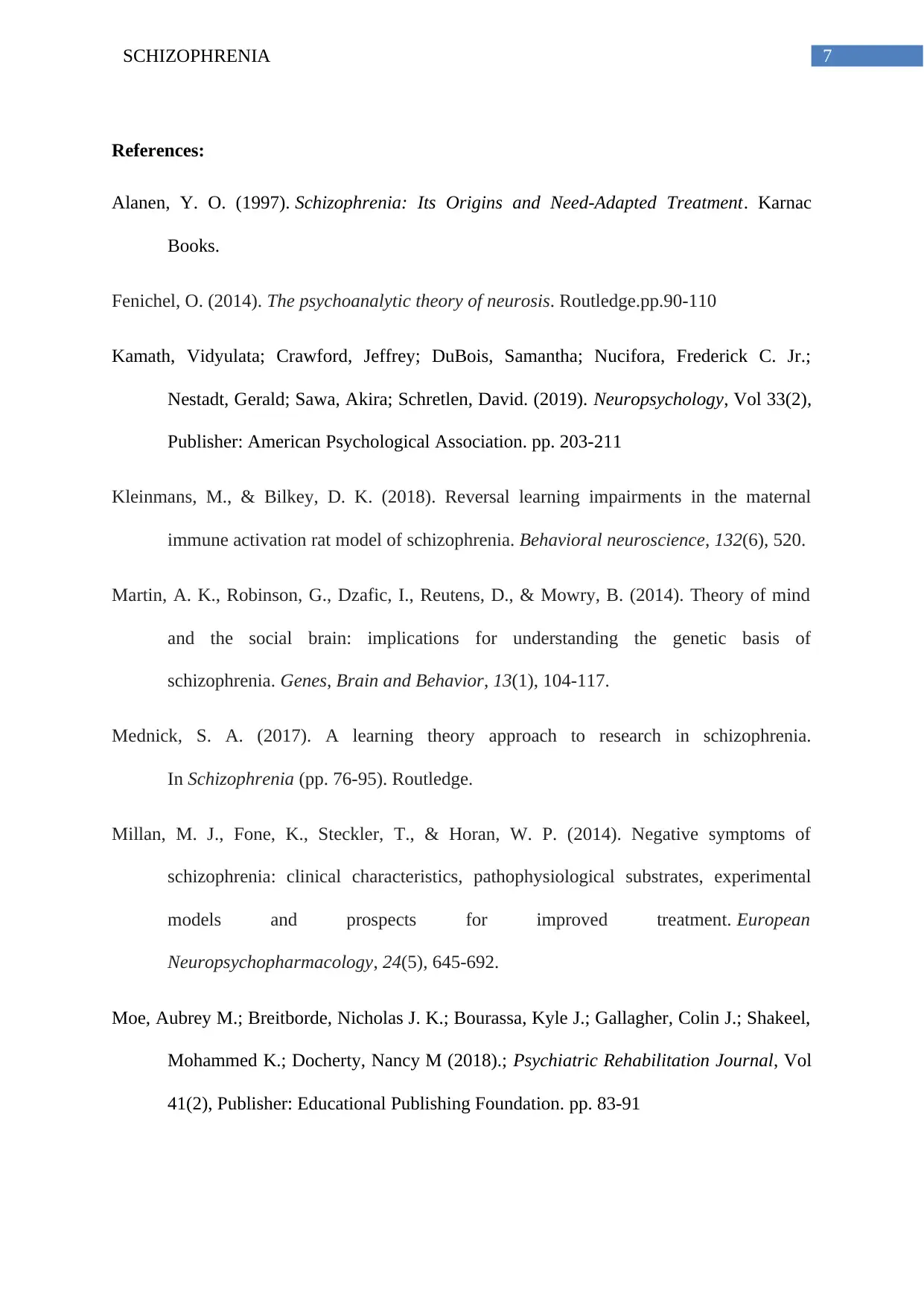
7SCHIZOPHRENIA
References:
Alanen, Y. O. (1997). Schizophrenia: Its Origins and Need-Adapted Treatment. Karnac
Books.
Fenichel, O. (2014). The psychoanalytic theory of neurosis. Routledge.pp.90-110
Kamath, Vidyulata; Crawford, Jeffrey; DuBois, Samantha; Nucifora, Frederick C. Jr.;
Nestadt, Gerald; Sawa, Akira; Schretlen, David. (2019). Neuropsychology, Vol 33(2),
Publisher: American Psychological Association. pp. 203-211
Kleinmans, M., & Bilkey, D. K. (2018). Reversal learning impairments in the maternal
immune activation rat model of schizophrenia. Behavioral neuroscience, 132(6), 520.
Martin, A. K., Robinson, G., Dzafic, I., Reutens, D., & Mowry, B. (2014). Theory of mind
and the social brain: implications for understanding the genetic basis of
schizophrenia. Genes, Brain and Behavior, 13(1), 104-117.
Mednick, S. A. (2017). A learning theory approach to research in schizophrenia.
In Schizophrenia (pp. 76-95). Routledge.
Millan, M. J., Fone, K., Steckler, T., & Horan, W. P. (2014). Negative symptoms of
schizophrenia: clinical characteristics, pathophysiological substrates, experimental
models and prospects for improved treatment. European
Neuropsychopharmacology, 24(5), 645-692.
Moe, Aubrey M.; Breitborde, Nicholas J. K.; Bourassa, Kyle J.; Gallagher, Colin J.; Shakeel,
Mohammed K.; Docherty, Nancy M (2018).; Psychiatric Rehabilitation Journal, Vol
41(2), Publisher: Educational Publishing Foundation. pp. 83-91
References:
Alanen, Y. O. (1997). Schizophrenia: Its Origins and Need-Adapted Treatment. Karnac
Books.
Fenichel, O. (2014). The psychoanalytic theory of neurosis. Routledge.pp.90-110
Kamath, Vidyulata; Crawford, Jeffrey; DuBois, Samantha; Nucifora, Frederick C. Jr.;
Nestadt, Gerald; Sawa, Akira; Schretlen, David. (2019). Neuropsychology, Vol 33(2),
Publisher: American Psychological Association. pp. 203-211
Kleinmans, M., & Bilkey, D. K. (2018). Reversal learning impairments in the maternal
immune activation rat model of schizophrenia. Behavioral neuroscience, 132(6), 520.
Martin, A. K., Robinson, G., Dzafic, I., Reutens, D., & Mowry, B. (2014). Theory of mind
and the social brain: implications for understanding the genetic basis of
schizophrenia. Genes, Brain and Behavior, 13(1), 104-117.
Mednick, S. A. (2017). A learning theory approach to research in schizophrenia.
In Schizophrenia (pp. 76-95). Routledge.
Millan, M. J., Fone, K., Steckler, T., & Horan, W. P. (2014). Negative symptoms of
schizophrenia: clinical characteristics, pathophysiological substrates, experimental
models and prospects for improved treatment. European
Neuropsychopharmacology, 24(5), 645-692.
Moe, Aubrey M.; Breitborde, Nicholas J. K.; Bourassa, Kyle J.; Gallagher, Colin J.; Shakeel,
Mohammed K.; Docherty, Nancy M (2018).; Psychiatric Rehabilitation Journal, Vol
41(2), Publisher: Educational Publishing Foundation. pp. 83-91
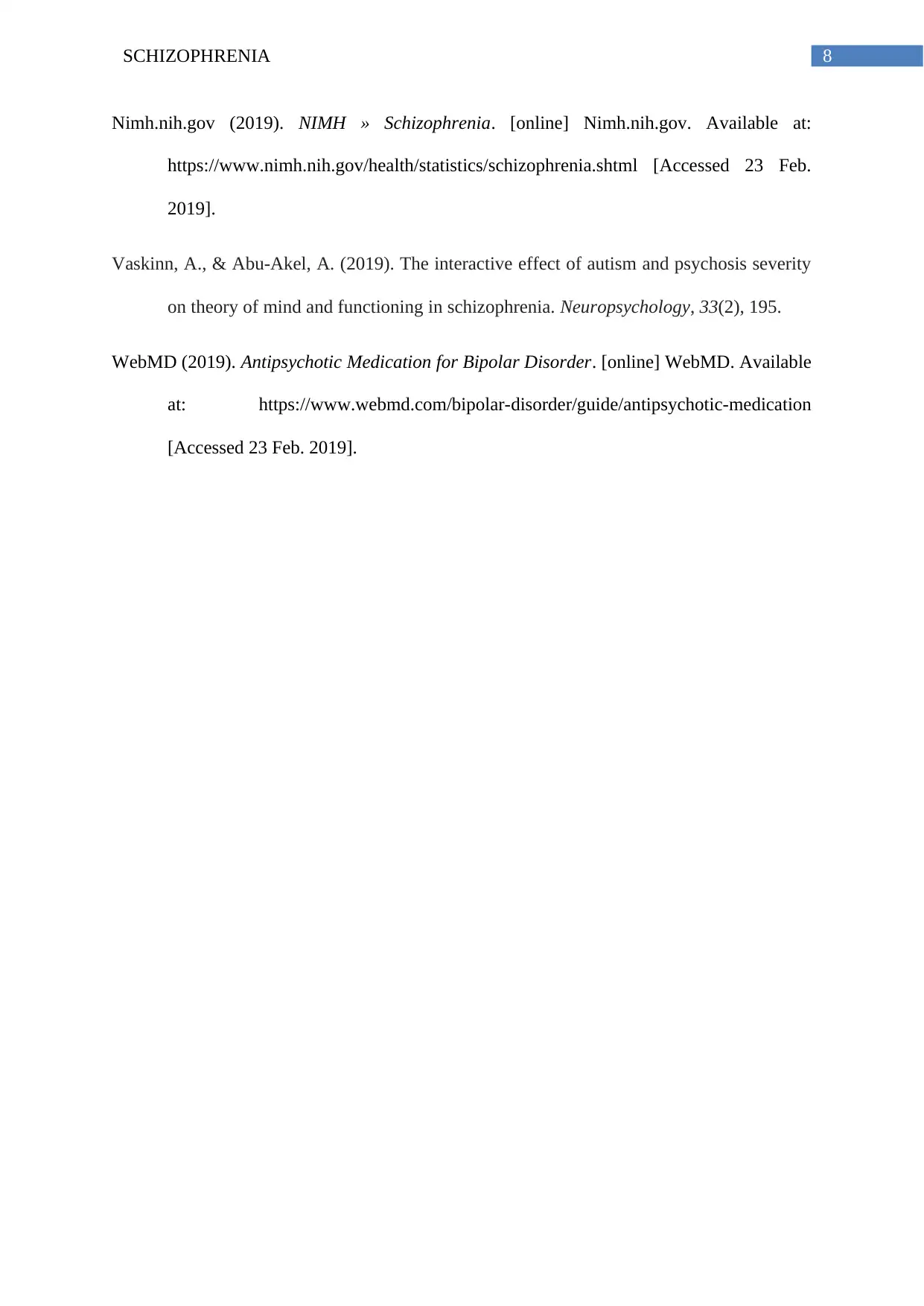
8SCHIZOPHRENIA
Nimh.nih.gov (2019). NIMH » Schizophrenia. [online] Nimh.nih.gov. Available at:
https://www.nimh.nih.gov/health/statistics/schizophrenia.shtml [Accessed 23 Feb.
2019].
Vaskinn, A., & Abu-Akel, A. (2019). The interactive effect of autism and psychosis severity
on theory of mind and functioning in schizophrenia. Neuropsychology, 33(2), 195.
WebMD (2019). Antipsychotic Medication for Bipolar Disorder. [online] WebMD. Available
at: https://www.webmd.com/bipolar-disorder/guide/antipsychotic-medication
[Accessed 23 Feb. 2019].
Nimh.nih.gov (2019). NIMH » Schizophrenia. [online] Nimh.nih.gov. Available at:
https://www.nimh.nih.gov/health/statistics/schizophrenia.shtml [Accessed 23 Feb.
2019].
Vaskinn, A., & Abu-Akel, A. (2019). The interactive effect of autism and psychosis severity
on theory of mind and functioning in schizophrenia. Neuropsychology, 33(2), 195.
WebMD (2019). Antipsychotic Medication for Bipolar Disorder. [online] WebMD. Available
at: https://www.webmd.com/bipolar-disorder/guide/antipsychotic-medication
[Accessed 23 Feb. 2019].
1 out of 9
Related Documents
Your All-in-One AI-Powered Toolkit for Academic Success.
+13062052269
info@desklib.com
Available 24*7 on WhatsApp / Email
![[object Object]](/_next/static/media/star-bottom.7253800d.svg)
Unlock your academic potential
© 2024 | Zucol Services PVT LTD | All rights reserved.





